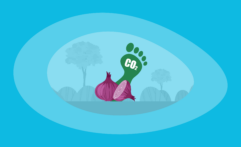The Environmental Impact of Figs: From Farm to Table
Impactful Ninja is reader-supported. When you buy through links on our site, we may earn an affiliate commission.
Learn more
Learn more
.
Hey fellow impactful ninja ? You may have noticed that Impactful Ninja is all about providing helpful information to make a positive impact on the world and society. And that we love to link back to where we found all the information for each of our posts. Most of these links are informational-based for you to check out their primary sources with one click. But some of these links are so-called "affiliate links" to products that we recommend. First and foremost, because we believe that they add value to you. For example, when we wrote a post about the environmental impact of long showers, we came across an EPA recommendation to use WaterSense showerheads. So we linked to where you can find them. Or, for many of our posts, we also link to our favorite books on that topic so that you can get a much more holistic overview than one single blog post could provide. And when there is an affiliate program for these products, we sign up for it. For example, as Amazon Associates, we earn from qualifying purchases. First, and most importantly, we still only recommend products that we believe add value for you. When you buy something through one of our affiliate links, we may earn a small commission - but at no additional costs to you. And when you buy something through a link that is not an affiliate link, we won’t receive any commission but we’ll still be happy to have helped you. When we find products that we believe add value to you and the seller has an affiliate program, we sign up for it. When you buy something through one of our affiliate links, we may earn a small commission (at no extra costs to you). And at this point in time, all money is reinvested in sharing the most helpful content with you. This includes all operating costs for running this site and the content creation itself. You may have noticed by the way Impactful Ninja is operated that money is not the driving factor behind it. It is a passion project of mine and I love to share helpful information with you to make a positive impact on the world and society. However, it's a project in that I invest a lot of time and also quite some money. Eventually, my dream is to one day turn this passion project into my full-time job and provide even more helpful information. But that's still a long time to go. Stay impactful,Affiliate Disclosure
Why do we add these product links?
What do these affiliate links mean for you?
What do these affiliate links mean for us?
What does this mean for me personally?
![]()
Figs are a sweet, squishy fruit popular in Italian cuisine. They are also becoming increasingly popular in the US, with the fresh fig market valued at around $1.5 billion. But as profitable and delicious as they are, figs can also negatively impact the environment in a number of ways. So we had to ask: What is the environmental impact of figs?
Figs have a very minimally negative environmental impact. They require a significant amount of irrigation and have a moderate carbon footprint. However, overall, their impact is very low compared to other fruits because of their carbon sequestering properties and low pesticide use.
In this article, we will examine the environmental impact of figs from several different angles. We will go through the life-cycle of figs, detailing their impact on the environment from growth to distribution to your plate to waste management. We will then compare the environmental impact of figs to that of other fruits. And, finally, we’ll share some tips with you on how you can reduce your own environmental impact and offset your own carbon emissions – both for your personal life and figs-related.
Here’s How We Assessed the Environmental Impact of Figs
The Environmental Impact Assessment (EIA) is one of the ways we measure the potential environmental effects of our actions, like the consumption of figs. It is a holistic assessment based on the environmental changes associated with our consumption. Those are changes in our environment that can have adverse effects on the air, land, water, fish, and wildlife or the inhabitants of the ecosystem.
“Environmental Impact: the effect that the activities of people and businesses have on the environment”
Cambridge Dictionary
Basically, all goods and services you buy – including figs – leave an impact on our environment. When it comes to food in general, and figs in specific, the following are key factors:
- Land requirements: Large parts of the world that were once covered by forests and wildlands are now used for agriculture. 10 million hectares of forest are destroyed annually and 50% of the world’s habitable land is now used for agriculture. This loss of natural habitat has been the main driver for reducing the world’s biodiversity.
- Water footprint: 70% of global freshwater is now used for agricultural purposes. By assessing the water footprint of a particular food, we can determine how our limited freshwater resources are being consumed and polluted.
- Pesticide and fertilizer usage: Pesticides and fertilizers provide a range of agricultural benefits. However, numerous studies link pesticides and fertilizers to serious effects on human health, along with disruptions to vital ecosystems and the spread of aquatic dead zones.
- Carbon footprint: The carbon footprint is one of the ways we measure the effects of our human-induced global climate change. Today, food production accounts for over a quarter (26%) of global greenhouse gas emissions.
- Waste generation: Food and its packaging account for almost 45% of the materials landfilled in the US alone. And packaging sent to landfills, especially when made from plastics, does not degrade quickly or, in some cases, at all.
To understand the overall environmental impact of figs, we must assess each of their key factors. This Environmental Impact Assessment (EIA) is a tool originally developed to identify the environmental impacts of a project prior to decision-making and also helps us to evaluate the environmental impacts of figs, from farm to table.
Here’s the Overall Environmental Impact of Figs
The overall environmental impact of figs is very minimal. The only real negative impacts they have are because of high irrigation amongst US-grown figs and a moderately high carbon footprint. However, besides these things, their impact is very small, and even positive in some ways.
Figs are very environmentally-conscious fruits. They sequester carbon very well, provide habitats and food for wildlife, and have even been used to restore rainforests. However, there are still a few things that they do that can harm the environment.
So, let’s have a look at the environmental impact of each key factor of figs!
| Key Assessment Factors | Environmental Impact |
| Land requirements for figs | Figs’ land requirements are somewhat high. However, their benefits for wildlife and biodiversity, such as habitat creation, mean that their impact on the environment is actually fairly positive at this stage. |
| Water footprint of figs | Figs have a high water requirement of 50–75 inches of water per year. Considering that they grow in dry regions, figs require a significant amount of irrigation which can have a negative impact on the environment. |
| Agrochemical usage for figs | Figs’ agrochemical use is very low. This is true despite the fact that they use a small amount of harmful nitrogen fertilizer. |
| Carbon footprint of figs | Figs have a moderate carbon footprint of 0.3kg (0.68lb) of CO2e per pound of figs. This is mainly because of their high irrigation requirements, mechanized harvesting processes, refrigerated trucking, and plastic packaging. |
| Waste generation of figs | Figs’ waste generation is fairly high. This is exacerbated by the fact that their waste has low composting and recycling rates. |
These are the overall summaries, but there is a lot more to the story. In the next few sections, we will dive deeper into each stage to illustrate to you all the important aspects of figs’ environmental impact.
What Are the Land Requirements for Figs
Figs’ land requirements are somewhat high. However, their benefits for wildlife and biodiversity, such as habitat creation, mean that their impact on the environment is actually fairly positive at this stage.
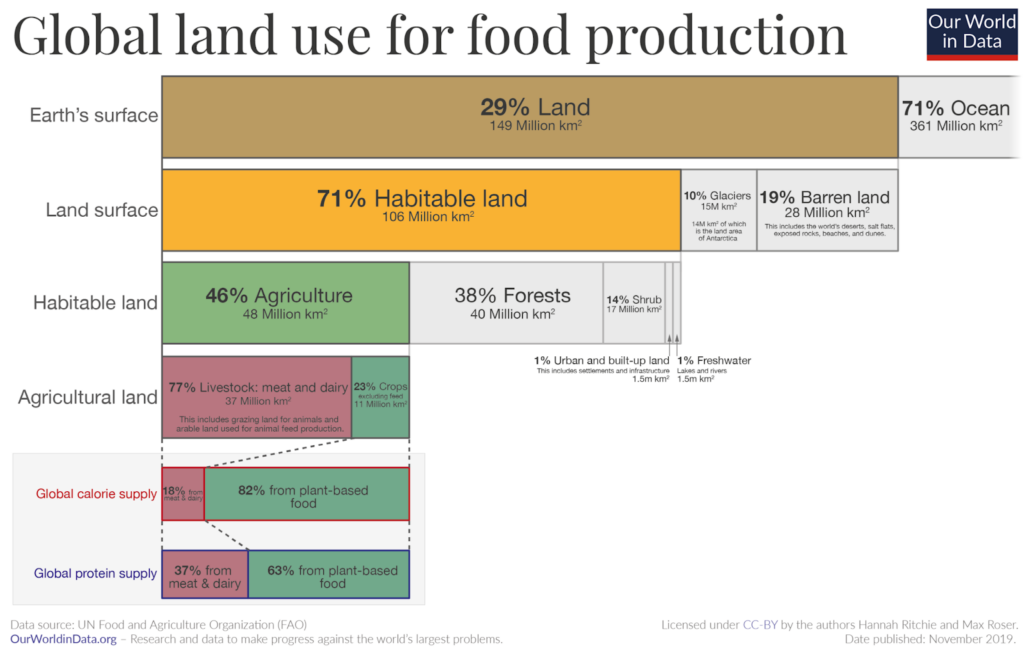
Growing figs has a lot of variables that contribute to their environmental impact. The amount of land they use, the way in which they grow, and the amount of time they take to grow will all contribute to their environmental impact.
How do the land requirements of figs impact their environmental footprint?
- What is the land usage of figs: Figs yield around 12 tons per hectare. This is a fairly low yield amongst fruits. For example, bananas can yield up to 100 tons per hectare. Though it is not the lowest of all, since watermelons only yield around 2–3 tons per hectare. So, the growth yield of figs contributes moderately to their environmental impact.
- Where and how are figs grown: Most figs are grown in Turkey on trees in orchards. All trees sequester carbon, meaning that they capture carbon from the atmosphere and store it in the ground. Fig trees have particularly excellent carbon sequestering properties, which is good news for their carbon footprint and thus their environmental impact. Fig trees tend to naturally occur in monocultures. However, their monocultures are not as harmful to wildlife as other monocultures can be, since they fruit year-round, so they don’t limit pollinators.
- How does the growing of figs affect soil fertility and erosion: Fig trees are generally considered beneficial to the environment and are heavily used in forest restoration projects. However, figs can also have some impact on the surrounding area and the soil, mainly through their roots’ invasiveness. Therefore, if planted responsibly, figs can help restore biodiversity to an area, but if not, they can choke out other plants and make soil uninhabitable.
- How does the figs industry affect the loss of habitable land: Fig trees certainly use a significant amount of land because of their lower yield. However, they are also excellent at attracting biodiversity and reforesting depleted areas. Because fig trees are tropical and a natural habitat for many tropical species, they are a favorite for rainforest reforestation in particular. In this way, fig trees can actually have a positive impact on the environment.
- How does the figs industry affect wildlife and biodiversity: Fig trees are very beneficial to wildlife and biodiversity. This is mainly because they are an excellent food source for a variety of species. They especially support wasps and any fruit-eating animals with their constant-fruiting growth method.
In short, figs actually have a moderately positive impact on the environment. Though they use a significant amount of land, they bring considerable benefits to it.
What Is the Water Footprint of Figs
Figs have a high water requirement of 50–75 inches of water per year. Considering that they grow in dry regions, figs require a significant amount of irrigation which can have a negative impact on the environment.
Water usage is one of the most important factors in the environmental impact of a fruit. The amount of water used, as well as the way they affect the water sources around them, are all major contributing factors. Here, we will look at these different angles to figs’ water impact.
How does the water footprint of figs impact their environmental footprint?
- What is the overall water usage of figs: Figs require around 50–75 inches of water per year. This is a fairly high water requirement amongst fruits. For example, cherries only need around 35 inches of water per year, though watermelons require up to 100.
- What is the green water footprint of figs: The green water footprint is the amount of water from precipitation stored in the soil and used by plants for growth. Most US-consumed figs are grown in California and Texas. California only gets around 23 inches of rain per year and Texas only about 27 inches. Thus, all of the regions’ rainfall needs to go towards figs’ water requirements.
- What is the blue water footprint of figs: The blue water footprint is the amount of water sourced from surface (such as rivers or lakes) or groundwater resources. Because figs’ water requirements are far above what Texas or California’s rainfall can provide, they will need significant irrigation. Irrigation is very detrimental to the environment for several reasons, but mainly because it creates groundwater imbalances.
- What is the gray water footprint of figs: The gray water footprint is the amount of freshwater required to clean up water pollution to meet certain quality standards. Essentially, it’s the amount of water needed to make polluted water clean enough to be safe and healthy for humans and the environment. Figs have low pesticide use and so don’t need a significant amount of water to clean up their pesticide residues.
- How does the figs industry affect freshwater and ocean pollution: The fact that figs don’t use a significant amount of pesticides means that they will pollute waterways less than fruits with high pesticide use. However, their use of significant irrigation can pollute the waterways through excess salt.
In short, figs’ use of considerable irrigation raises their environmental impact. However, their low pesticide use reduces their potential for a larger impact.
What Is the Agrochemical Usage for Figs
Figs’ agrochemical use is very low. This is true despite the fact that they use a small amount of harmful nitrogen fertilizer.
Pesticides and fertilizers are agrochemicals that can have a significant impact on the environment. They both require resources to create as well as have effects on the life around them. Here, we will look at how figs’ pesticide and fertilizer rates affect their environmental impact.
How does the agrochemical usage of figs impact their environmental footprint?
- What is the pesticide usage of figs: Figs have low pesticide usage in general. This means that they avoid many of the environmental damages that pesticides can cause.
- What is the fertilizer usage of figs: Fig trees generally don’t need a significant amount of fertilizer, unless the soil they are growing in is particularly barren. However, more major farms may use fertilizer, often a general purpose NPK (nitrogen, phosphorus, potassium) fertilizer. Potassium generally has very minimal environmental effects, whereas nitrogen has been found to be very damaging to the environment. However, fig trees’ use of nitrogen fertilizer is minimal and so not as impactful as a fruit tree which primarily uses nitrogen fertilizer, such as avocados.
- Are there any known issues connected to the agrochemical usage for figs: Nitrogen fertilizers can cause many problems with waterways in particular. This is because they promote invasive algae growth, which can harm many kinds of aquatic life.
In short, figs’ minimal pesticide and fertilizer use, despite the inclusion of nitrogen fertilizer, means their agrochemical footprint is low overall.
What Is the Carbon Footprint of Figs
Figs have a moderate carbon footprint of 0.3kg (0.68lb) of CO2e per pound of figs. This is mainly because of their high irrigation requirements, mechanized harvesting processes, refrigerated trucking, and plastic packaging.
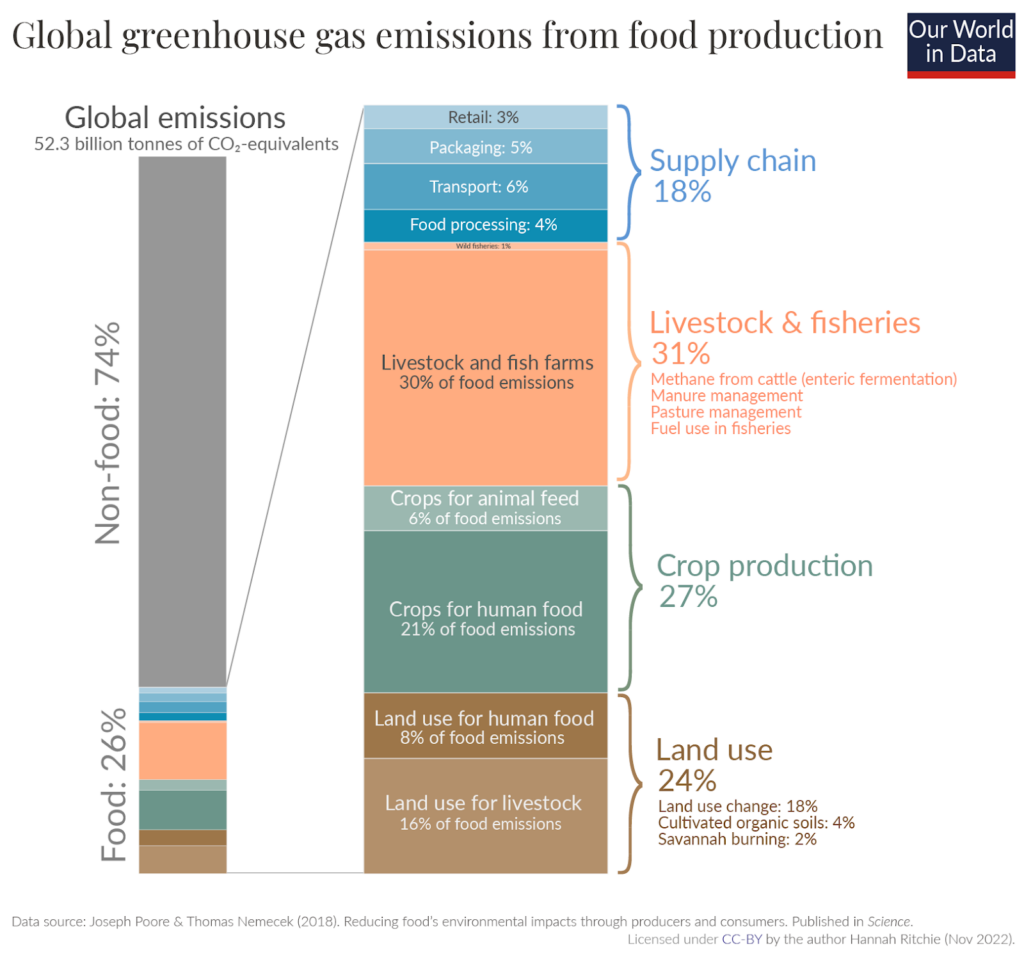
Carbon footprint is one aspect of the overall environmental impact of a fruit. It essentially measures how much carbon or other greenhouse gasses the production of figs emits into the atmosphere. Emissions from product manufacturing, irrigation, transportation fuel, and landfills all add up to create the overall carbon footprint of a fruit. Let’s see how the carbon footprint of figs breaks down and contributes to their environmental impact.
How does the carbon footprint of figs impact their environmental footprint?
- What is the overall carbon footprint of figs: The overall carbon footprint of figs is 0.3kg (0.68lb) of CO2e per pound of figs. This means that for every pound of figs produced, 0.3kg of carbon is released into the atmosphere. 0.3kg is a moderate carbon footprint compared to other fruits.
- What are the main contributors to the carbon footprint of figs: The main factors that contribute to figs’ carbon footprint are their mechanized harvesting, high irrigation requirements, low land yield, refrigerated trucking, low composting rates, and the use of plastic packaging.
- Which life-cycle stage of figs has the highest carbon footprint: The stage that contributes the most to figs’ carbon footprint is harvesting, processing, and packaging. This is because almost every step of this process requires energy, from harvesting machines to refrigerators. The use of plastic in their packaging process also creates emissions through plastic manufacturing.
In short, figs have a fairly average carbon footprint amongst fruits. Their emissions mainly come from their irrigation requirements, plastic packaging, and refrigeration needs.
What Is the Waste Generation of Figs
Figs’ waste generation is fairly high. This is exacerbated by the fact that their waste has low composting and recycling rates.
When fruit waste, either packaging or organic materials, is disposed of, it can have a major impact on the environment. Whether it’s damaging wildlife, getting into oceans, emitting methane, or dissolving into microplastics that contaminate groundwater, all these materials have their part to play. In this section, we will look at how figs’ waste affects the environment.
How does the waste generation of figs impact their environmental footprint?
- What is the packaging of figs: Figs are mainly packaged in plastic clamshells. Plastic creates significant environmental damage just in its manufacturing process. These damages include extracting and burning fossil fuels, runoffs harming local wildlife, and emissions harming the health of nearby people. The use of plastic packaging contributes very negatively to figs’ environmental impact.
- How is the packaging of figs disposed of: Plastic is one of the worst materials to dispose of. Though some plastic is recyclable, only 9% of plastic is actually successfully recycled, leaving the other 91% for the landfill. Landfills cause significant environmental damage and so the more un-recycled plastic there is, the more damage it can do. Plastic is also notorious for breaking down into microplastics, which pollute groundwater and can even end up in food.
- How are figs disposed of: Figs have peels that generally aren’t eaten. Unfortunately, despite the fact that they can be composted, only 4% of food actually ends up in the compost. This means that a good portion of the figs are put in landfills. When food goes into landfills it creates methane, a greenhouse gas. Thus, figs’ low composting rates contribute very negatively to their overall environmental impact.
In short, the disposal of figs comes at a high environmental cost. The low composting rates of food waste and low recycling rates of plastic mean most fig waste is put in landfills.
What Have Been Historical Environmental Issues Connected to the Fig Industry
The fig industry has historically had a minimal impact on the environment. They have not contributed majorly to land loss or water pollution.
All fruits have had a complex road toward global distribution. They originate in one part of the world and often travel far to end up in your local supermarket. From farm to table, some of our favorite fruits have racked up some serious environmental damage along the way. Whether it’s deforestation to meet demand, water pollution, or disruption of wildlife, most fruits have left a path of destruction. Let’s see how figs have fared throughout history.
What have been the key environmental issues of the figs industry?
- How much land has been lost because of figs production: Figs have a low land yield, so their land use is high. However, figs are not as popularly farmed as more common fruits like oranges and apples. Global fig farming only amounts to around 1 million tons a year, whereas oranges were evaluated at 50 million tons a year and apples at around 76 million tons. Therefore, they have not had as much of a historical burden on land use as other fruits.
- Which wildlife species have been negatively impacted or displaced because of fig production: Since fig trees make excellent habitats for wildlife, providing food sources and pollination, they have had some positive impacts over the years. They also have had historically low pesticide rates which has helped them to minimize their impact on wildlife.
- Have water sources and soil been contaminated because of fig production: The fact that fig trees have used small amounts of pesticides and fertilizer means that their impact on water sources has been low. However, their small amount of nitrogen fertilizer may have had some impacts on waterways.
In short, figs have historically had very little impact on the environment. Their low land usage, pesticide and fertilizer rates, and positive relationship with wildlife have left a small negative impact on the environment.
What Is the Overall Environmental Impact of Food and Agriculture
Food production in general has a high environmental impact. Everything from the amount of land used to the energy involved in irrigation to its effect on plant and animal biodiversity can be a factor in this. In the chart below, you can see how food production is one of the biggest influences on these areas of the environment.
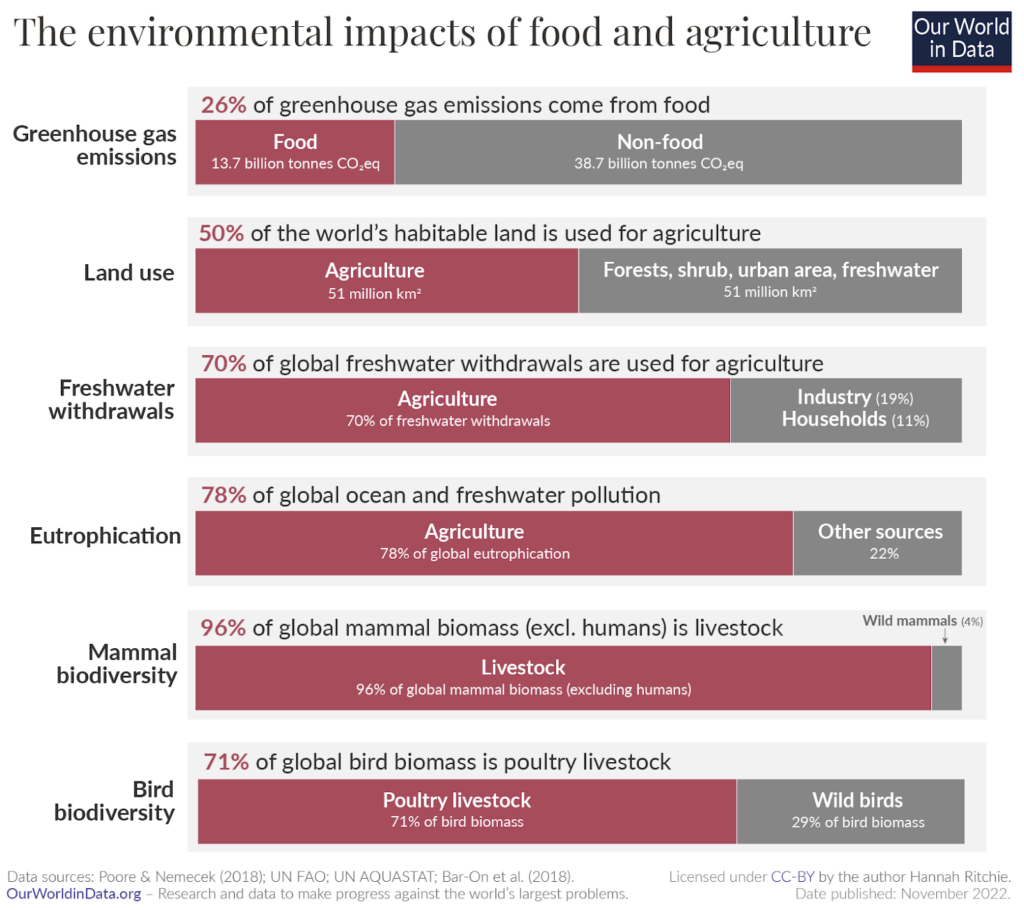
Agriculture alone accounts for over a quarter of global greenhouse gas emissions, while using half of the world’s habitable land and 70% of the global freshwater withdrawals. Agriculture also causes 78% of the global ocean and freshwater pollution.
Livestock accounts for the vast majority of non-human mammal and bird biomass. Mammal livestock outweighs wild mammals by a factor of 15-to-1, and poultry livestock outweighs wild birds by a factor of more than 3-to-1.
These statistics highlight the need for sustainable and responsible practices in food production to reduce its impact on the environment. And the need for us to shift toward more environmentally-friendly foods.
How Can You Reduce Your Environmental Impact and Offset Your Personal Carbon Footprint
There are a few things you can do to mitigate some of the negative environmental effects of consuming figs, while still enjoying them. You can also consider offsetting your personal and figs-related carbon emissions, which work to remove carbon emissions elsewhere that are then attributed to you. Here, we will walk you through how to accomplish both of these things.
How Can You Reduce Your Environmental Impact When Shopping for Figs
In this section, we give you a short list of ways you can reduce the negative environmental effects of figs, based on those parts of the life-cycle of figs that would otherwise most negatively impact the environment:
- Avoid plastic packaging: Both at the manufacturing stage and the disposal stage, plastic packaging has a detrimental effect on the environment. Buy figs with alternative or biodegradable packaging, or no packaging at all, to greatly reduce your fig environmental impact.
- Compost and recycle: If it isn’t possible to avoid plastic packaging altogether, then you should make the effort to recycle or reuse it as much as possible. Likewise, you should try to compost your fig waste. If your city doesn’t have a composting system, then you can consider building one yourself!
- Grow your own figs: If you want to cut down on travel times and ensure that no dangerous pesticides are being used on your figs, the only surefire way is to grow them yourself. They grow mainly in hot climates, so if you live in the Southern US, then you will be able to grow your own figs!
Following some of these methods can really help you to cut down on your environmental impact of eating figs. None of these will completely eradicate these negative impacts, since there are always effects that may be outside of your control. But some reduction is always better than nothing!
Which Organizations Can You Support to Help Alleviate Your Environmental Impact
While figs can cause a wide range of environmental damage, there are also some organizations that help you reduce parts of your impact that would otherwise be outside of your control. These organizations are working hard to prevent and reverse damage to the environment caused by industries like figs agriculture.
In the table below are some of the best environmental charities that work in the areas where figs production has affected the environment – and beyond:
Though it is helpful to reduce the environmental impact of your personal figs consumption, supporting these organizations takes your positive impact a step further. You will be reaching far beyond your own consumption impacts and helping to build a better world for everyone!
How Can You Offset Your Personal Carbon Footprint
The carbon footprint is a key part of your environmental impact. And it is one of the ways we measure the effects of our human-induced global climate change. Yes, even from eating figs!
“Carbon footprint: the amount of greenhouse gasses and specifically carbon dioxide emitted by something (such as a person’s activities or a product’s manufacture and transport) during a given period”
Merriam Webster
Basically, it is the amount of carbon emitted by you as an individual or an organization providing you with goods and services – including figs:
- This includes GHG emissions from producing the products that we use and foods that we eat (e.g., power plants, factories or farms, and landfills)
- GHG emissions from fuel that we burn directly or indirectly (e.g., logistics and transportation, cooling or heating facilities),
- as well as the GHG emissions attributed to how we consume these products and foods.
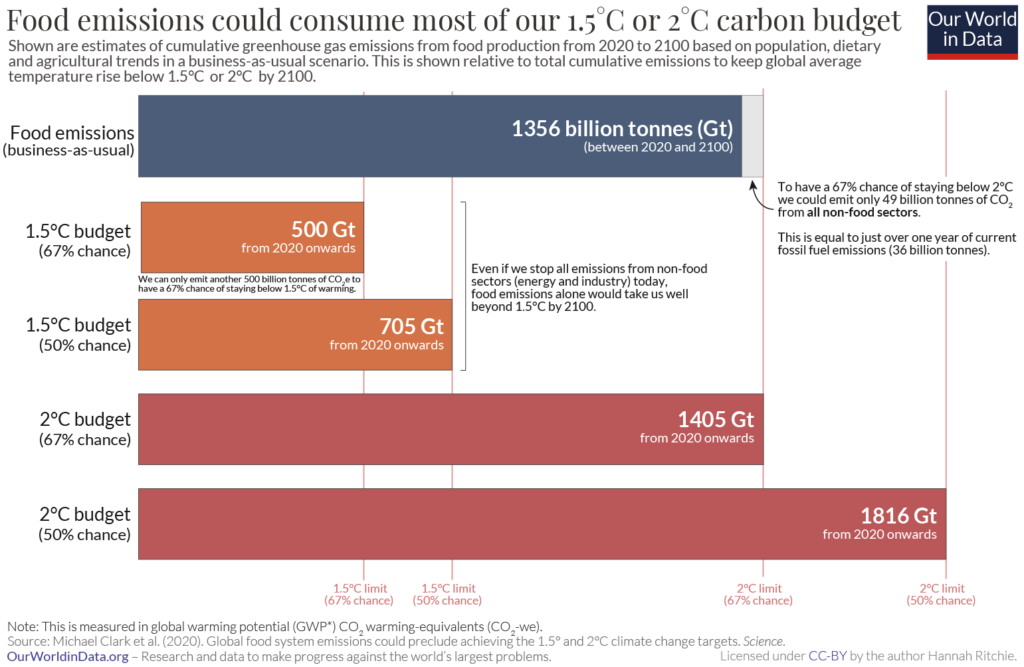
Carbon offsets are reductions in carbon emissions that are used to compensate for carbon emissions occurring elsewhere – for example for the carbon emissions that are associated with figs. They are measured in tons of CO2 equivalents and are bought and sold through international brokers, online retailers, and trading platforms on what is known as the global carbon offset market.
“Carbon Offset: a way for a company or person to reduce the level of carbon dioxide for which they are responsible by paying money to a company that works to reduce the total amount produced in the world, for example by planting trees”
Oxford Dictionary
In terms of figs – and indeed all food types – there will always be a carbon footprint, because of the resources it takes to get your food from farms to the place where you’ll eventually eat them. And while there are ways to reduce your carbon footprint when shopping for figs, carbon offsets would be a way to reduce your CO2e emissions all the way down to net zero (or even to become climate positive).
However, when you purchase carbon offsets, it’s important that they actually make a difference in offsetting (aka reducing) total carbon emissions. To achieve that, the following are key criteria:
- Carbon offset projects have to be effective (different projects have different effectiveness rates)
- Carbon offset projects have to be additional
- Carbon offset projects have to be permanent
- The claims from carbon offset projects have to be verifiable
To find the best carbon offsets for you personally, check out our full guide on the best carbon offsets for individuals, where you’ll also learn more about how these carbon offset projects work, what their respective offsetting costs are, and what your best way would be to offset your own carbon emissions.
Final Thoughts
Figs are some of the most environmentally-conscious fruits out there. Their impacts on land and water sources are very low, mainly because of their lower land usage and their minimal pesticide and fertilizer rates. They do require higher amounts of irrigation when grown in the US, and their carbon footprint is moderate. But with some reduction methods, such as cutting down on packaging and even potentially growing your own figs, you can become a much more environmentally responsible fig consumer!
Stay impactful,

Sources
- Italian Food Forever: All About Figs
- Future Market Insights: Fresh Figs Market
- UN Environment Programme: Environmental Impact Assessment and Strategic Environmental Assessment: Towards an Integrated Approach
- Our World in Data: The environmental impacts of food and agriculture
- Our World in Data: Global land use for food production
- World Health Organization: Preventing disease through healthy environments: a global assessment of the burden of disease from environmental risks
- ScienceDirect (Biological Conservation): Worldwide decline of the entomofauna: A review of its drivers
- EPA: The Sources and Solutions: Agriculture
- EPA: Reducing Food Waste and Packaging
- FoodPrint: The Environmental Impact of Food Packaging
- Gardening Know How: Water Requirements for Fig Trees
- Impactful Ninja: What is the Carbon Footprint of Figs
- Agrifarming: Fig Farming Project Report
- Impactful Ninja: What is the Carbon Footprint of Bananas
- Impactful Ninja: What is the Carbon Footprint of Watermelons
- World Mapper: Fig Production by Country
- RHS: How to Grow Figs.
- Woodland Trust: How Trees Capture and Store Carbon
- Pubmed: Using Fig and Eucalyptus for Restoration
- Sweets on Groves: Limes
- Saveur: Evolution is so Cool and so Gross
- Food Unfolded: How Fig Trees Restore Forests and Biodiversity
- Permaculture News: Dig the Fig
- Agrifarming: Fig Farming Project Report
- Mongabay: Can Fig Trees Regrow Lost Rainforests
- Water Footprint Network: What Is a Water Footprint?
- Gardening Knowhow: How to Water a Cherry Tree
- The Spruce Eats: History of Figs
- OEHHA: Oregon Precipitation
- Weatherstem: Texas Annual Precipitation
- Gardening Knowhow: Irrigating Fig Trees
- National Geographic: Environmental Impacts of Agricultural Modification
- Hello Magazine: The Foods You Should Always Buy Organic
- FAO: Environmental Considerations in Irrigation
- GOV.BC: Environmental Protection and Pesticides
- Wilson Bros Gardens: How to Fertilize and Water a Fig Tree
- Fig Nut: How to Fertilize a Fig Tree
- Direct Farm: Potassium
- Mitsui: Reducing the Environmental Impact of Chemical Fertilizers
- Impactful Ninja: What is the Carbon Footprint of Avocados
- Figs 4 Fun: Crop Profile for Figs in California
- Actahort: Effect of Temperature on the Shelf Life of Figs
- EPA: Reducing the Impact of Wasted Food
- The Produce Nerd: Fresh Fig Harvesting and Packing
- OECD: Increased Plastic Leakage and Greenhouse Gas Emissions
- Biological Diversity: The Plastic Production Problem
- Also Known As: 12 Interesting Facts About Packaging Waste and Disposal
- Colorado: The Hidden Damage of Landfills
- UNEP: How Tiny Plastic Particles Are Polluting Our Soil
- BBE: How Plastic is Getting Into Our Food
- Taste of Home: How to Eat Figs
- GOV.BC: Waste Management
- Techno-Preneur: Fig Farming
- World Atlas: Top Orange Producing Countries in the World
- Agribenchmark: World Apple Production
- SN Applied Sciences Journal: Worldwide pesticide usage and its impacts on ecosystem
- Our World in Data: Global greenhouse gas emissions from food production
- Our World in Data: The environmental impacts of food and agriculture
- Earth Easy: Composting
- RHS: How to Grow Figs
- Impactful Ninja: Best charities that fight to protect our environment
- Impactful Ninja: Best charities for reforestation
- Impactful Ninja: Best wildlife conservation charities
- Impactful Ninja: Best charities for protecting the Amazon rainforest
- Impactful Ninja: Best charities that protect our national parks
- Impactful Ninja: Best charities that fight for clean water
- Impactful Ninja: Best charities that help conserve our rivers
- Impactful Ninja: Best charities to save our oceans
- Impactful Ninja: Best charities that help farmers
- Impactful Ninja: Best charities for helping farm animals
- Impactful Ninja: Best charities for climate change
- Impactful Ninja: Best carbon offsets for individuals
- Impactful Ninja: Best charities that fight to reduce food waste
- Impactful Ninja: Best charities that fight to end plastic pollution
- Our World in Data: Emissions from food alone would take us past 1.5°C or 2°C this century
- Impactful Ninja: Why Is a Carbon Footprint Bad for the Environment
- Impactful Ninja: Best Carbon Offsets for Individuals

